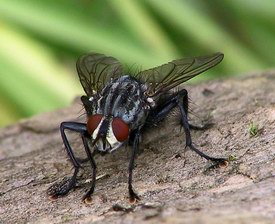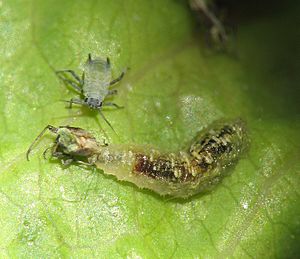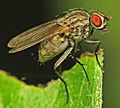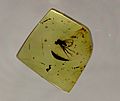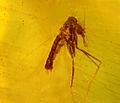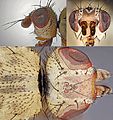Fly facts for kids
Quick facts for kids FlyTemporal range:
Middle Triassic – Recent, 245–0 mya |
|
|---|---|
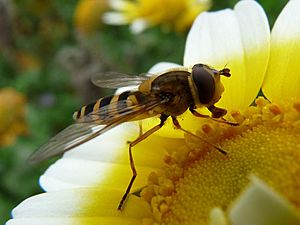 |
|
| A hoverfly, showing dipteran features: large eyes, small antennae, sucking mouthparts, single pair of flying wings, hindwings reduced to clublike halteres | |
| Scientific classification | |
| Kingdom: | |
| Class: | |
| Infraclass: | |
| Order: |
Diptera
|
A fly (plural: flies) is an insect that belongs to the group called Diptera. This is a large group of advanced flying insects.
The most obvious way to tell a true fly apart from other insects is by its wings. A typical fly has two main flying wings on its body (called the thorax). It also has a pair of small, club-shaped organs called halteres. These halteres used to be hind wings, but they changed over time. Now, they act like tiny gyroscopes, helping the fly balance and sense its movement in the air. Flies also have very large eyes that give them excellent wide-angle vision.
Because of their amazing eyes and halteres, flies are incredible fliers. They can avoid most predators easily. They are also one of the hardest insects to catch by hand! Their quick turns, dives, and sudden changes in direction are their main way to escape danger. Scientists have found that flies can make very fast and precise decisions to avoid threats. They do this with a brain as tiny as a grain of salt! It's like a newborn baby knowing how to fly a fighter jet perfectly.
Only one other small group of insects, the Strepsiptera, has two true wings and halteres. But for them, the halteres developed from their front wings, and their back wings are the ones they use for flying.
The fact that true flies have only one pair of main wings helps us tell them apart from other insects that have "fly" in their name. For example, mayflies, dragonflies, damselflies, stoneflies, whiteflies, fireflies, sawflies, caddisflies, butterflies, or scorpionflies are not true flies.
Some true flies have even lost their wings over time. This includes some flies that live in colonies with other insects.
Flies also go through a complete change, called metamorphosis. This means they have four life stages: egg, larva, pupa, and adult.
Contents
What are the different kinds of flies?
Scientists believe there might be as many as 1,000,000 different kinds of flies in the world. However, only about 150,000 species have been officially named and described so far.
There are many different types of flies you might know. Houseflies are usually grey or black. You can find them almost anywhere people live. Horse flies and deer flies are known for biting people and animals. Fruit flies are often found near fruit that is getting too ripe. Hoverflies look a lot like small wasps, but they are harmless and do not sting.
Some insects are true flies, even if their name doesn't include "fly." For example, Mosquitoes are flies that bite people. They can also spread diseases, like malaria. Midges are tiny flies, a bit like mosquitoes, but not all midges bite. Gnats are also small flies that sometimes gather in large groups called "swarms."
On the other hand, some insects have "fly" in their name but are not true flies at all!
- Fireflies are actually a type of beetle that can make its own light.
- Dragonflies and damselflies belong to a different group called Odonata. They are not real flies.
- Butterflies are also not flies. They are part of the Lepidoptera group, along with moths.
How do flies look and work?
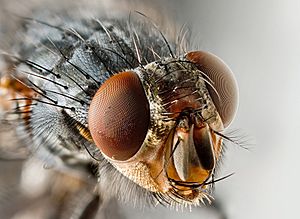

Flies are built for flying. They usually have short, smooth bodies that help them move through the air. A fly's head has ocelli (simple eyes), antennae, large compound eyes, and mouthparts. The middle part of the fly's body, the thorax, holds the wings and strong flight muscles. The third part of the thorax has the halteres, which help the fly balance when it flies.
Flies have a head that can move around. Most flies have large compound eyes on the sides of their head. They also have three smaller simple eyes (ocelli) on top. Their antennae come in different shapes, but they are often short. This helps reduce drag when they are flying fast.
Flies do not have teeth or any other body parts that let them chew solid food. Because of this, flies can only eat liquid food. Their mouthparts and digestive system are specially made for this diet. For example, female horse-flies have sharp, knife-like mouthparts. They use these to make a small cut in an animal's skin and then lap up the blood. Flies also have special pouches in their gut. These pouches let them store small amounts of liquid food after a meal.
Fly reproduction and life cycle
Female flies lay their eggs as close as possible to a food source. The young flies grow very quickly. This allows the larvae to eat as much as they can in a short time before they change into adults. Some eggs hatch right after they are laid. Other flies are ovoviviparous, meaning the larvae hatch inside the mother's body before being laid.
Young fly larvae do not have true legs. Some fly larvae, like those of black flies or horse-flies, have special leg-like parts called prolegs. These help them hold onto things in flowing water, or onto the tissues of animals they are feeding on.
There are some differences between the larvae of different fly groups. For example, in some flies like mosquitoes, the head and body parts are easy to see. But in other flies, the head of the larva is not clearly separate from the rest of its body. These larvae are often called maggots. Maggots usually have very small or no eyes and antennae. This simple body shape helps them live in places like rotting food or inside other animals.
The pupae (the stage after larva) can look different depending on the fly species. Some pupae even develop inside a silk cocoon. After the adult fly comes out of the pupa, it usually lives only for a few days. Its main jobs are to reproduce and to find new food sources.
What are maggots?
Maggots are the larvae of flies. They are very useful to forensic scientists who study crimes. By looking at how developed maggots are on a dead body, scientists can figure out how long ago someone died. They can also tell where the death happened.
Scientists can even use DNA to identify the exact species of maggot. A housefly maggot is about 10–20 mm (⅜–¾ in) long. In the summer, a new generation of flies (from egg to adult) can grow in just 12 to 14 days. Other insects, like some beetles, eat maggots. If there are no maggots on a body, it might mean the time of death was longer ago.
Maggots are also raised by people for different uses. They are popular bait for angling (fishing). They are also used as food for pets that eat meat, like reptiles or birds.
In medicine, maggots are sometimes used to clean out dead tissue from wounds. This is called maggot therapy. They are also used in making some special foods, like casu marzu cheese. This cheese is made to rot as part of its aging process.
In Japan, large numbers of flies are raised to help pollinate sunflowers in greenhouses. The maggots are especially useful for this.
Images for kids
-
A fossil fly (brachyceran) found in Baltic amber. It is about 50 million years old.
-
The head of a horse-fly showing its large compound eyes and strong piercing mouthparts.
-
A tabanid fly flying.
-
The large bee-fly, Bombylius major, looks like a bee to trick predators.
-
An Anopheles stephensi mosquito drinking human blood. This species can carry malaria.
-
Flies in research: Drosophila melanogaster fruit fly larvae being grown in tubes for genetics studies.
-
Casu marzu is a traditional cheese from Sardinia that contains the larvae of the cheese fly.
See also
 In Spanish: Dípteros para niños
In Spanish: Dípteros para niños


